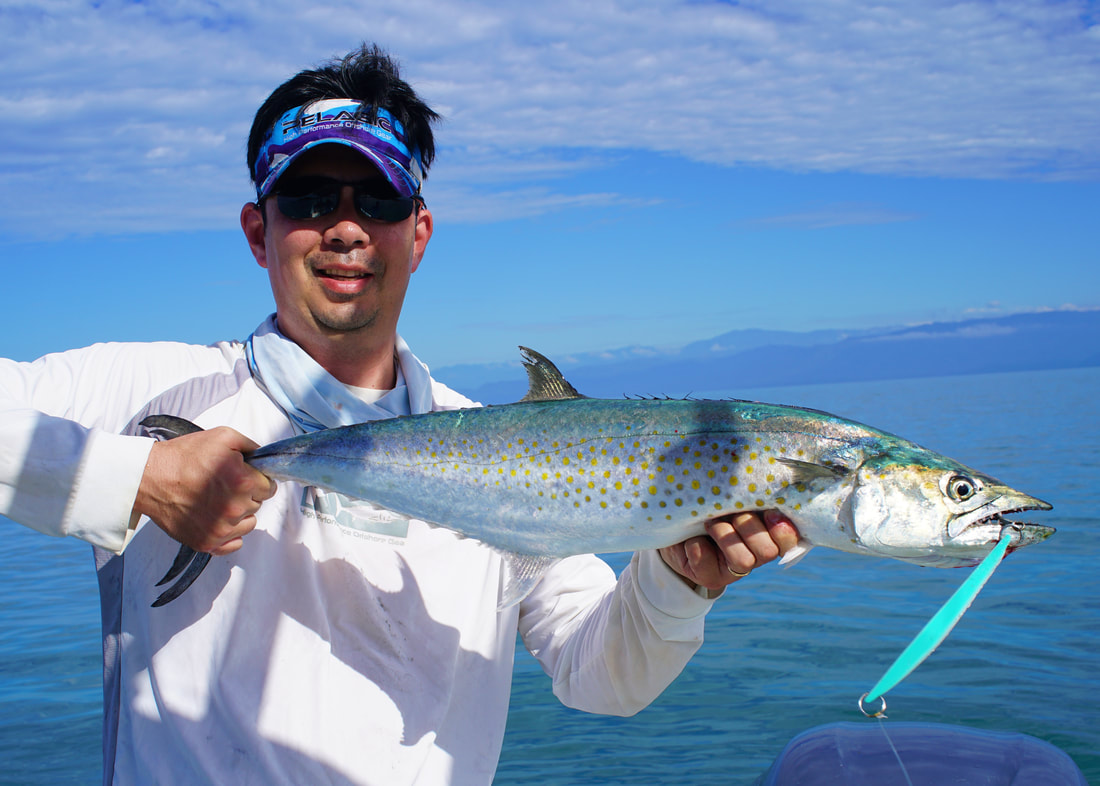Surface Irons
Surface irons are the lighter versions of the "iron" family of lures that are popular on the West Coast of the United States. I rarely see them used anywhere else, which is a pity because they work well for a wide variety of species of fish. They are pretty easy to use, with just a straight retrieve whose speed is dictated by the species being pursued. They are probably most commonly used for California Yellowtail, which like a fast retrieve. Lots of species of snapper like them, and for those a slow retrieve works best. They kick back and forth in a seductive way, with an occasional irregular wider kick, near the surface that makes them perfect for swimming over shallow reefs.
The Tady 45 is one of the lightest irons and works best in calm conditions. For rougher conditions, I like to use a heavier iron like the Tady Starman, Tady 4/0 or Salas 7X. These lures stay down better in choppy seas, unlike the 45 which can plane up.
There are many companies that make surface irons, but the ones I buy the most by far are made by Tady and Salas. Both individually sand their lures, so different individual jigs may swim differently. Off-center holes and irregular "hips" on the sides can give individual jigs better irregular swimming action. Holding the ring and seeing if you can spin the jig around easily is another test you can do to see how it might perform in the water. The bigger the hole at the top, the more action it will typically have. When you tie the surface iron on, make sure you tie the knot near the weld so that it doesn't interfere with the action.
In terms of size, I generally like to "match the hatch" on what the fish are eating. If they are keyed in on small bait, throwing a big iron may not generate much interest (although sometimes it does).
Many experienced iron fishermen do not think color is a very important factor, especially compared to swimming action. That said, it does have some impact on whether a lure gets bit most of the time. Personally I find myself using mint and white quite a bit, as well as other shades of green, blue, and yellow.
Surface irons are the lighter versions of the "iron" family of lures that are popular on the West Coast of the United States. I rarely see them used anywhere else, which is a pity because they work well for a wide variety of species of fish. They are pretty easy to use, with just a straight retrieve whose speed is dictated by the species being pursued. They are probably most commonly used for California Yellowtail, which like a fast retrieve. Lots of species of snapper like them, and for those a slow retrieve works best. They kick back and forth in a seductive way, with an occasional irregular wider kick, near the surface that makes them perfect for swimming over shallow reefs.
The Tady 45 is one of the lightest irons and works best in calm conditions. For rougher conditions, I like to use a heavier iron like the Tady Starman, Tady 4/0 or Salas 7X. These lures stay down better in choppy seas, unlike the 45 which can plane up.
There are many companies that make surface irons, but the ones I buy the most by far are made by Tady and Salas. Both individually sand their lures, so different individual jigs may swim differently. Off-center holes and irregular "hips" on the sides can give individual jigs better irregular swimming action. Holding the ring and seeing if you can spin the jig around easily is another test you can do to see how it might perform in the water. The bigger the hole at the top, the more action it will typically have. When you tie the surface iron on, make sure you tie the knot near the weld so that it doesn't interfere with the action.
In terms of size, I generally like to "match the hatch" on what the fish are eating. If they are keyed in on small bait, throwing a big iron may not generate much interest (although sometimes it does).
Many experienced iron fishermen do not think color is a very important factor, especially compared to swimming action. That said, it does have some impact on whether a lure gets bit most of the time. Personally I find myself using mint and white quite a bit, as well as other shades of green, blue, and yellow.
Some of the various Snapper species I have caught on surface irons:
Barred Pargo in particular love surface irons:
Some other species readily caught on surface irons:














